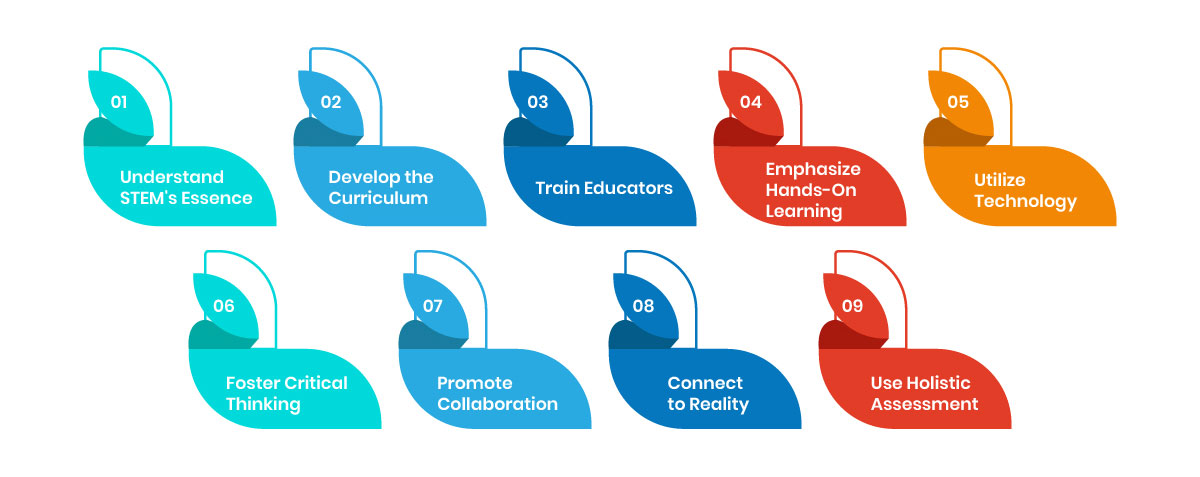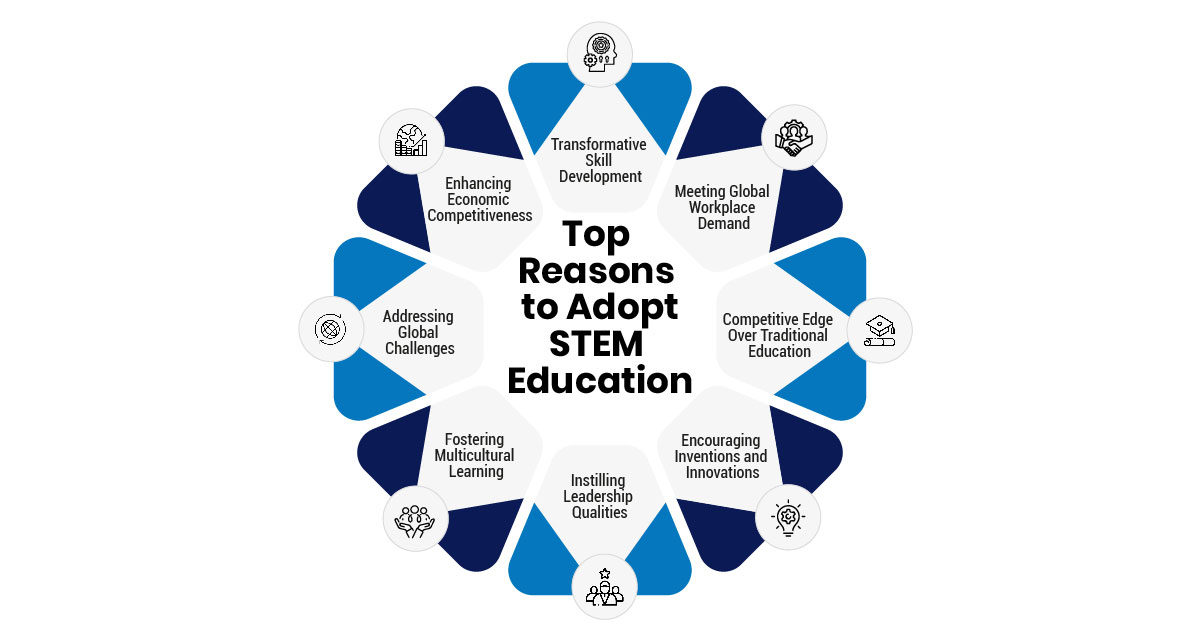Unlocking the Significance of STEM Education: Key Insights
April 19, 2024In today’s evolving era of technology and innovation, it is vital to keep the education system afloat by meeting the needs and demands of an emerging generation. Inculcation of STEM curriculum into the education system is one of the best things that can be done to improvise the younger generation to a higher level of intellect and skills. Now, let’s take a deeper look at STEM education and its importance.
What is STEM Education?
STEM education, an interdisciplinary approach, integrates Science, Technology, Engineering, and Mathematics, fostering critical thinking and real-world application. It aims to equip students with skills vital for success in a technology-driven society, nurturing creativity, problem-solving, and digital literacy.
Through hands-on projects and collaborative learning, STEM bridges theoretical knowledge with practical solutions, preparing students for diverse career paths and addressing global challenges.
It emphasizes inquiry-based learning, encouraging students to explore, innovate, and apply knowledge in meaningful ways, ultimately shaping future innovators and problem-solvers.
STEM education prioritizes skill development, knowledge acquisition, and creative thinking, empowering students to thrive in a rapidly evolving world.
Why is it Important to Implement STEM in K-12 Education
Implementing STEM education in K-12 settings is paramount for preparing students for the challenges and opportunities of life.
Beyond the classroom, STEM education cultivates essential skills like creativity, critical thinking, and problem-solving, which are vital in navigating today's complex society by making informed decisions and adapting to evolving technological landscapes.
It also brings in economic growth and innovation to a nation as there is a rapid growth of STEM industries and graduates with STEM skills are in high demand.
Most importantly, STEM education addresses pressing global issues such as medical advancements and climate change by instilling an innovative and inquisitive mindset in students. We surely know that these are the pressing issues, and the upcoming generation has the biggest role to play thus becoming agents of positive change in their communities and beyond.
So, implementing STEM education in K-12 settings is crucial for fostering the next generation of thinkers, problem-solvers, and innovators.
How to Implement STEM Education
As we have seen how important it is to implement STEM education, let us take a closer look at how to make it practical through these steps:

- Understand STEM's Essence: Before starting, grasp that STEM integrates Science, Technology, Engineering, and Mathematics to tackle real-world issues and promote critical thinking.
- Develop the Curriculum: Collaborate on crafting a curriculum aligned with standards, promoting cross-disciplinary exploration and hands-on experiences.
- Train Educators: Provide professional development in STEM pedagogy, teaching strategies, and technology integration, empowering educators as facilitators.
- Emphasize Hands-On Learning: Design projects requiring students to apply theoretical knowledge practically, encouraging experimentation and problem-solving.
- Utilize Technology: Integrate interactive tools like simulations and software to enhance understanding and teach technology as an inquiry tool.
- Foster Critical Thinking: Encourage open-ended questioning and exploration of diverse perspectives to nurture critical thinking skills.
- Promote Collaboration: Design projects that require teamwork, communication, and sharing ideas, fostering a collaborative classroom culture.
- Connect to Reality: Highlight practical applications of STEM through guest speakers and field trips, linking classroom learning to real-world contexts.
- Use Holistic Assessment: Develop assessment strategies that evaluate problem-solving, creativity, teamwork, and knowledge application, considering project-based assessments and portfolios.
Top Reasons to Adopt STEM Education and Its Benefits
To unlock the future potential of STEM education judiciously, awareness about the benefits it brings forth is necessary which in turn motivates implementors to adopt the STEM system. So, let us check out few major reasons to adopt STEM education below:

-
Transformative Skill Development:
STEM education fosters the development of crucial skills such as creativity, critical thinking, logical analysis, and teamwork.Students learn to approach problems from multiple angles and devise innovative solutions, preparing them for success in various fields.
-
Meeting Global Workplace Demands:
With nearly 8.8 percent growth in jobs projected in STEM-related fields by 2029, adopting STEM education equips students with the skills needed to meet the demands of the global workforce.Graduates with STEM backgrounds have international recognition and are well-positioned for career opportunities worldwide.
-
Competitive Edge Over Traditional Education:
STEM students gain a competitive edge over those from traditional education systems.Their interdisciplinary approach to learning and practical application of knowledge set them apart, making them desirable candidates for higher-paying jobs and innovative roles.
-
Encouraging Inventions and Innovations:
STEM education nurtures a culture of innovation by providing students with opportunities to learn both theoretically and practically.By challenging students to solve real-world problems, STEM cultivates creativity and instills an aptitude for invention, driving advancements in various fields.
-
Instilling Leadership Qualities:
Through rigorous problem-solving and resilience-building activities, STEM education instills leadership qualities in students. They learn to view challenges as opportunities for growth and develop the confidence to tackle complex issues, both professionally and personally. -
Fostering Multicultural Learning:
STEM education promotes diversity and inclusivity by providing equal opportunities for students from diverse backgrounds. It prepares students to thrive in multicultural environments and empowers them to contribute to a global society. -
Addressing Global Challenges:
Similarly, STEM equips students with the skills and knowledge needed to address pressing global challenges, such as climate change, healthcare disparities, and food security.By stimulating critical thinking and problem-solving abilities, STEM empowers students to create innovative solutions for a better world.
-
Enhancing Economic Competitiveness:
Countries with well-developed STEM education systems tend to be leaders in technological innovation and economic growth.By investing in STEM education, nations can enhance their economic competitiveness on a global scale, creating jobs and driving prosperity.
Overall, adopting STEM education is essential for preparing students for the future workforce, driving technological advancements, fostering innovation, and addressing global challenges. It offers a pathway to success in a rapidly evolving world driven by science, technology, engineering, and mathematics.
Conclusion
The implementation of STEM education in K-12 settings is not merely a pedagogical trend but a strategic imperative for preparing the next generation to thrive in an increasingly complex and technology-driven world.
By integrating Science, Technology, Engineering, and Mathematics, STEM education equips students with essential, most demanding and new generational skills with creativity. It facilitates innovation, addresses global challenges, and enhances economic competitiveness on a global scale.
Moreover, STEM education instills leadership qualities, promotes diversity, and empowers students to become agents of positive change in not only their communities but beyond that.
Therefore, embracing STEM education is not just about shaping individual career paths but about shaping the future of society as a whole.
It is a catalyst for unlocking human potential and driving progress in the ever-evolving landscape of the 21st century.
As we embark on this journey, let us recognize the significance of STEM ducation in shaping a brighter and more sustainable future for generations to come.




